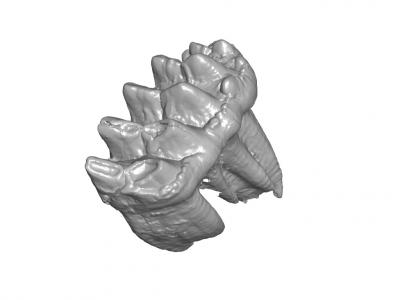Last Saturday Henry Kietzman was plowing for his brother John Kietzman on the Robert Hawthorne farm northwest of Roberts when his plow turned over a large tooth of some prehistoric animal, perhaps a mastodon,. The tooth is a most perfect specimen. There are seven well developed roots, each about four inches long and from two to three inches across at the base. There are nine crushing surfaces with wide spaces between. Two of these prongs are broken off. One was worn down somewhat from use in eating.
The tooth has a depth from top of crown to end of roots of about seven or eight inches. From back to front it is about seven inches and in width about four inches. It weighs 4 lbs. 6 ounces. The enamel is in excellent state of preservation and the whole tooth has the appearance of not having been in the ground more than a few months whereas it probably has lain in the peat bog of that farm for thousands of years. The fact that it was in peat bog would indicate that it is of comparative recent origin as the peat is the latest land formation here.
Later: O.C. Dilks took the tooth to Chicago yesterday and had it looked over at the Field Museum. They said it is a mastodon tooth and has been in the ground only one or two thousand years.
--Roberts Herald. 5 May 1926
Jackie found this article on line. So obviously they have the dates incorrect. As the newspaper article I found in the Roberts Herald was dated 1926. (Unless I wrote the dates down wrong.) For some reason I think this find was short drive from the Arnold farm. On the road out to the farm.
Hawthorne Farm, Ford Co., IL. Mammut americanum, M3
Submitted by cwidga on Tue, 02/10/2015 - 09:03
Model Image:

Repository:
Illinois State Museum, Research and Collections Center, Springfield, IL
Taxon:
Mammut Americanum (Mammalia: Proboscidea: Mammutidae)
Chronological Age:
12,250+/-40 14C BP
This is a 3D scan acquired via Next Engine laser scanner of an upper right 3rd permanent molar from the Hawthorne Farm mastodon.
Locality and Horizon:
Hawthorne Farm, Ford Co., IL. From "Mire Peat". Discovered in 1955 and excavated in 1956. This mastodon is notable because it is a mature individual of very small size. The molar enamel is also very rugged.
Specimen details:
Illinois State Museum, Research and Collections Center, Springfield, IL. Upper third, right, molar of Hawthorne Farm Mastodon from Ford Co., IL. Specimen is associated with partial skeleton of a small, mature, female mastodon dating to ~14,000 years ago.
Citation:
Saunders et al., 2010Saunders, J. J., Grimm, E. C., Widga, C. C., Campbell, G. D., Curry, B. B., Grimley, D. A., ... & Treworgy, J. D. (2010). Paradigms and proboscideans in the southern Great Lakes region, USA. Quaternary International, 217(1), 175-187.



No comments:
Post a Comment